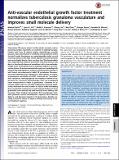Anti-vascular endothelial growth factor treatment normalizes tuberculosis granuloma vasculature and improves small molecule delivery
Author(s)
Datta, Meenal; Via, Laura E.; Kamoun, Walid S.; Liu, Chong; Chen, Wei; Seano, Giorgio; Weiner, Danielle M.; Schimel, Daniel; England, Kathleen; Martin, John Daniel; Gao, Xing; Xu, Lei; Barry, Clifton E.; Jain, Rakesh K.; ... Show more Show less
DownloadDatta-2015-Anti-vascular endoth.pdf (1.985Mb)
PUBLISHER_POLICY
Publisher Policy
Article is made available in accordance with the publisher's policy and may be subject to US copyright law. Please refer to the publisher's site for terms of use.
Terms of use
Metadata
Show full item recordAbstract
Tuberculosis (TB) causes almost 2 million deaths annually, and an increasing number of patients are resistant to existing therapies. Patients who have TB require lengthy chemotherapy, possibly because of poor penetration of antibiotics into granulomas where the bacilli reside. Granulomas are morphologically similar to solid cancerous tumors in that they contain hypoxic microenvironments and can be highly fibrotic. Here, we show that TB-infected rabbits have impaired small molecule distribution into these disease sites due to a functionally abnormal vasculature, with a low-molecular-weight tracer accumulating only in peripheral regions of granulomatous lesions. Granuloma-associated vessels are morphologically and spatially heterogeneous, with poor vessel pericyte coverage in both human and experimental rabbit TB granulomas. Moreover, we found enhanced VEGF expression in both species. In tumors, antiangiogenic, specifically anti-VEGF, treatments can “normalize” their vasculature, reducing hypoxia and creating a window of opportunity for concurrent chemotherapy; thus, we investigated vessel normalization in rabbit TB granulomas. Treatment of TB-infected rabbits with the anti-VEGF antibody bevacizumab significantly decreased the total number of vessels while normalizing those vessels that remained. As a result, hypoxic fractions of these granulomas were reduced and small molecule tracer delivery was increased. These findings demonstrate that bevacizumab treatment promotes vascular normalization, improves small molecule delivery, and decreases hypoxia in TB granulomas, thereby providing a potential avenue to improve delivery and efficacy of current treatment regimens.
Date issued
2015-02Department
Massachusetts Institute of Technology. Department of Chemical EngineeringJournal
Proceedings of the National Academy of Sciences
Publisher
National Academy of Sciences (U.S.)
Citation
Datta, Meenal, Laura E. Via, Walid S. Kamoun, Chong Liu, Wei Chen, Giorgio Seano, Danielle M. Weiner, et al. “Anti-Vascular Endothelial Growth Factor Treatment Normalizes Tuberculosis Granuloma Vasculature and Improves Small Molecule Delivery.” Proceedings of the National Academy of Sciences 112, no. 6 (February 10, 2015): 1827–32.
Version: Final published version
ISSN
0027-8424
1091-6490